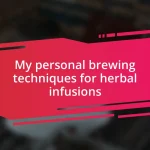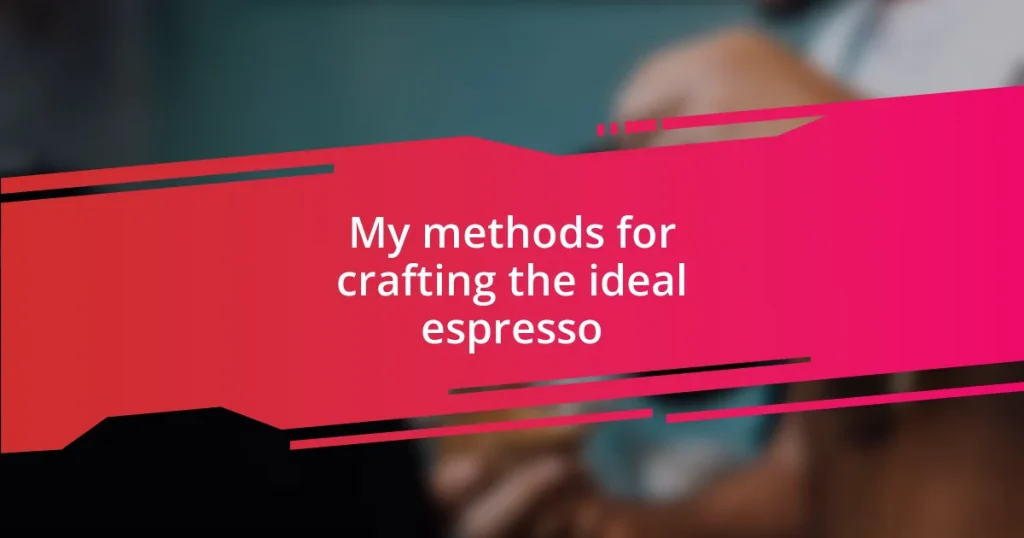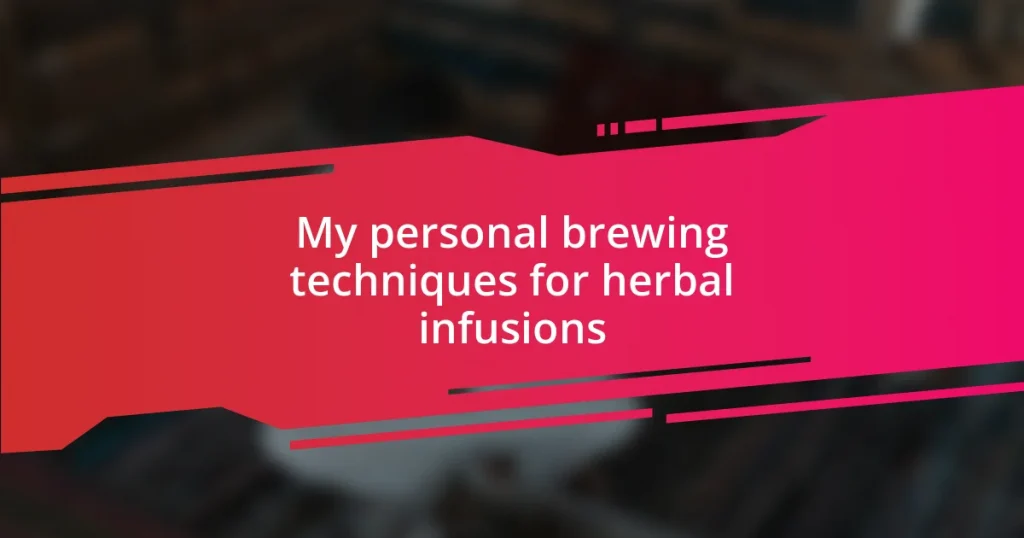Key takeaways:
- Craft beer classes enhance appreciation for brewing, develop social connections, and support local breweries.
- Learning essential brewing techniques and understanding different beer styles deepens the tasting experience and ignites passion for brewing.
- Engaging with the beer community fosters shared knowledge and enhances brewing skills through collaborations and discussions.

Benefits of Craft Beer Classes
One of the standout benefits of craft beer classes is the opportunity to deepen your appreciation for the brewing process. I remember the first time I learned about the difference between ales and lagers; it was like a light bulb moment for me. Understanding the science and art behind each style made every sip feel more significant—rather than just drinking a beer, I was experiencing a story in a glass.
These classes also provide a social experience that’s hard to replicate elsewhere. I recall chatting with fellow enthusiasts, sharing our favorite brews and discovering new flavors together. Isn’t it fascinating how a shared passion can spark friendships? It’s a unique context that fosters connection, bridging gaps between strangers through a mutual love for craft beer.
Additionally, craft beer classes often introduce you to the local brewing community. I’ve met some incredible brewmasters who are so passionate about their craft, and their enthusiasm is contagious. Have you ever wondered where your beer comes from and the people behind it? Learning about local breweries not only enriches your knowledge but also supports the small businesses that pour their heart into every batch.

Essential Brewing Techniques Acquired
When diving into craft beer classes, I discovered several essential brewing techniques that fundamentally transformed my approach to beer-making. For instance, understanding the significance of temperature control hit me hard during my first brewing session. It was astonishing to realize that even a few degrees could change the flavor of the final product. This newfound knowledge enhanced my confidence in approaching both brewing and tasting, leading to delicious outcomes.
Here are some key techniques I picked up along the way:
- Mashing: This process involves steeping grains in hot water to extract sugars, which is crucial for fermentation.
- Boiling: Learning how to properly boil the wort (unfermented beer) and time hop additions taught me about balancing bitterness and aroma.
- Fermentation Monitoring: Keeping a close eye on fermentation temperatures helped me understand how yeast behaves and influences flavor profiles.
- Sanitation Practices: I can’t stress enough how vital cleanliness is in brewing. I learned that even a tiny bit of contamination could ruin an entire batch.
- Tasting and Sensory Evaluation: Developing my palate for identifying flavors and aromas in various beers has been an exciting journey that enhances my appreciation for each brew I taste.
Emphasizing these techniques gave me a sense of ownership over the brewing process, reinforcing that beer is not just a drink, but a craft to be respected and celebrated. Each class was a stepping stone, increasing my enthusiasm and igniting a passion that has turned into an enjoyable hobby.

Understanding Beer Styles Deeply
Understanding different beer styles has been an eye-opener for me, elevating my tasting experience to new heights. During one memorable class, we explored the complex flavors of stouts versus porters. I remember taking that first sip of a rich imperial stout and marveling at how its chocolatey undertones danced with hints of coffee. By comparing the two side by side, it became clear that even subtle differences in ingredients, like the type of malt used, can create vastly different flavor profiles—a realization that brought an exhilarating depth to my appreciation of beer.
As I delved deeper into the world of beer styles, I took notes on how brewing techniques influence each one. For instance, the fermentation process for a Belgian ale allowed for unique fruity and spicy characteristics that I never noticed before. In my journey, I’ve also come to admire how different regions and cultures impart distinct qualities into their beers. Just thinking about that crisp, refreshing German pilsner always brings back memories of sitting in a beer garden, soaking in the atmosphere as I savored every gulp. It’s like a passport to different places with every pint.
To further clarify these unique styles, I found that comparing them side by side can be incredibly enlightening. Here’s a table that summarizes some of the key beer styles I learned about during my classes:
| Beer Style | Characteristics |
|---|---|
| Stout | Rich, dark, often with coffee and chocolate notes. |
| Porter | Slightly lighter than stout, with caramel and toffee flavors. |
| Belgian Ale | Fruity and spicy with a full-bodied mouthfeel. |
| German Pilsner | Crisp and refreshing with a floral hop aroma. |
Learning about these styles has not only deepened my understanding but has made every beer tasting an adventure that I now look forward to.

Flavor Pairing Skills Developed
One of the most exciting skills I developed in craft beer classes was flavor pairing, which added a whole new dimension to my tasting experiences. I vividly recall a session where we paired an aromatic IPA with spicy chicken wings. The bitterness of the hops beautifully cut through the heat, creating a symphony of flavors that buzzed on my palate. Have you ever tasted something that just clicked? That moment felt like magic, showing me the power of thoughtful pairings.
Experimenting with different food and beer combinations opened my eyes to a world of flavor harmony. For instance, I discovered how a fruity saison can complement a sweet dessert like a peach cobbler. The way the flavors mingled was nothing short of breathtaking. Each bite and sip made me realize that pairing isn’t just about contrast; sometimes, it’s about enhancing the natural notes of both the food and the beer. It’s like a dance, with both elements guiding each other to something truly memorable.
Reflecting on my experiences, I’ve become much more confident in my abilities to create these pairings during gatherings. I remember hosting a small dinner party where I paired a chocolate stout with a rich, creamy cheesecake, and let me tell you, it was a showstopper. People were raving about the combination, and it filled me with such joy to see everyone enjoying the experience. This skill has transformed my approach to both cooking and entertaining, proving that the right beer can elevate any meal from ordinary to exceptional.

Crafting Your Own Recipes
Crafting your own beer recipes is like creating a unique piece of art that reflects your tastes and experiences. I remember my first attempt at brewing a pale ale. The excitement of measuring out the grains and hopping the brew was electrifying! I felt an odd sense of ownership over this mix, as if I were an alchemist conjuring something magical in my kitchen. Have you ever had that thrill of mixing ingredients, wondering how each choice shapes the outcome?
As I experimented, I learned that adjusting one small element could lead to surprisingly different flavors. I once swapped out a standard malt for a more caramelized variety, and the result was an unexpected warmth that elevated the beer beyond my expectations. It reminded me of how life is filled with choices, and even the smallest changes can make a huge difference in the end product. This delightful journey through flavors became a personal exploration where each batch revealed a bit more about my palate and preferences.
Creating my own recipes has transformed the way I perceive brewing. It’s not just about following a formula; it’s about discovery. I’ve come to embrace failures as learning experiences. I clearly remember a batch that ended up tasting a bit too sour. Instead of feeling defeated, I viewed it as a stepping stone that taught me the balance between hops and malt. It was a valuable lesson, reminding me that even missteps can lead to new and exciting flavor profiles. Isn’t it fascinating how every brew tells a story—my story?

Choosing Quality Ingredients
When choosing quality ingredients, I’ve learned that the grains, hops, and yeasts you select can dramatically shape your brew’s character. During one class, I discovered the importance of sourcing fresh and local ingredients. It was eye-opening to taste the difference between a standard malt and one that had been freshly milled. The latter added a depth of flavor that I hadn’t experienced before, almost like tasting sunshine in a bottle. Have you ever wondered how fresh ingredients can transform a dish or drink?
Hops, in particular, have a fascinating impact on flavor profiles. I vividly remember a session dedicated to exploring different hop varieties. After tasting a brew infused with Citra hops, I was blown away by the burst of citrus notes it offered. It was as if biting into a ripe grapefruit! This experience taught me to appreciate hops not just for bitterness, but for the incredible aromatics they offer. It’s a sensory journey that makes each brewing adventure uniquely rewarding.
Furthermore, yeast is often considered the unsung hero of brewing. I’ve found that experimenting with various yeast strains can yield surprising results. I once brewed a Belgian-style beer with a specific yeast that added spicy and fruity notes I hadn’t anticipated. It took my understanding of flavor development to another level. Isn’t it incredible how a small, living organism can transform a simple mix of water, malt, and hops into something complex and delightful? These factors have become key elements that guide my ingredient choices, highlighting that the right selections can elevate a brew from good to exceptional.

Engaging with the Beer Community
Engaging with the beer community has truly enriched my brewing experience. I vividly recall my first visit to a local beer festival. The atmosphere was electric, filled with passionate brewers and enthusiastic tasters like myself. I found it thrilling to chat with homebrewers, sharing tips while sampling a variety of craft beers. Isn’t it incredible how a shared love for beer can create such immediate connections?
Attending meetups and workshops further opened my eyes to the importance of community. One memorable session focused on pairing food with beer, led by a local chef and a brewer. As we tasted dishes alongside perfectly matched brews, I felt a sense of camaraderie with fellow beer lovers, all of us eager to discover new flavors together. It was as if we were part of a secret society, sharing our narratives and preferences over pints. Have you ever felt that sense of belonging just by sharing a drink with others?
Now, I actively participate in online forums and social media groups dedicated to craft beer enthusiasts. It’s fascinating to see how diverse perspectives contribute to our understanding of brewing techniques and beer styles. I often find myself diving deep into discussions about sour ales or experimenting with barrel aging after hearing someone else’s success story. Engaging with others not only enhances my brewing skills but also reminds me that we all have our unique journeys in this delightful world of craft beer. Isn’t it wonderful how a single interest can bring together people from all walks of life?















